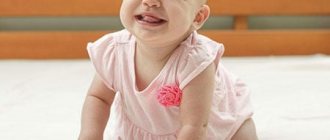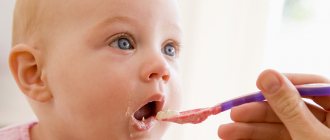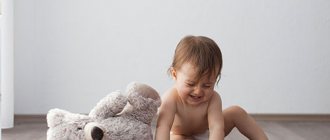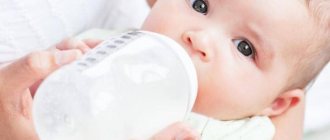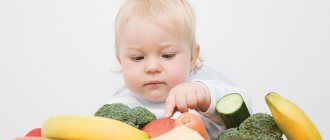Daily routine for a 10 month old baby
A 10-month-old baby becomes more independent and calm. His daily routine, if followed regularly, will stabilize. When making plans for the day, you need to take into account the time of meals, sleep, and wakefulness. It is necessary to leave space for developmental activities, walks and free play.
An example of a daily routine is presented in the table by hour:
| Time | Class |
| 7:00 | Awakening |
| 7:30 – 8:00 | Morning routines |
| 8:00 – 9:00 | Breakfast |
| 9:00 – 10:00 | Wakefulness |
| 10:00 – 11:30 | First dream |
| 11:30 – 15:30 | Wakefulness |
| 12:30 | Dinner |
| 13:00 | Walk |
| 15:30 – 17:00 | Second dream |
| 17:00 | Afternoon snack |
| 17:30 | Developmental activities |
| 18:00 – 19:30 | Wakefulness, games |
| 19:30 | Bathing |
| 20:00 | Dinner |
| 20:30 – 21:00 | Laying down |
| 21:00 – 7:00 | Night sleep (with a break for one feeding) |
It is good to occupy the morning period of wakefulness with active games, gymnastics or massage. Developmental activities should be done after sleep, when the baby has rested and can exercise a little; in the evening it is better not to do outdoor games, as there is a risk of overstimulating the child, then he will have trouble falling asleep. It is useful to develop fine motor skills, look at books, crawl or walk. Let your child help with household chores.
Remember that this daily routine is approximate, it is important to listen to the baby. There are active and calm children, owls and larks. The optimal time between rests is 3.5-4 hours, and the routine is built according to this.
Regimen of a 10 month old bottle-fed baby
The daily routine of a 10-month-old baby on artificial feeding is very similar to the routine with natural nutrition. The baby sleeps during the day a maximum of 3 times, eats 5-6 times a day, and walks 2 times.
Table of contents
|
What is mode and its functions
A routine is a rational distribution of time for various activities throughout the day.
The regime includes the following activities:
- dream;
- catering;
- walks;
- games;
- hygiene measures;
- physical education.
The daily routine is scheduled hourly.
Organizing the day hourly helps to improve the baby’s well-being, increase immunity, discipline, and accustom him to the kindergarten routine.
By dividing the day by hours, the baby develops a sense of time.
Approximate daily routine at 10 months of age:
| Time | Activities |
| 6:00 — 10:00 | waking up, breakfast, hygiene measures, gymnastic exercises |
| 10:00 — 10:30 | 2 breakfast |
| 10:30 – 12:00 | sleep during the day |
| 12:00 – 14:00 | games, walk |
| 14:00 – 14:30 | dinner |
| 14:00 – 15:30 | staying awake, reading, playing |
| 15:30 – 17:00 | sleep in the evening |
| 17:00 – 18:00 | wakefulness |
| 18:00 – 18:30 | dinner |
| 18:30 – 19:30 | walk |
| 19:30 – 21:30 | games, reading books |
| 21:30 – 22:00 | 2 dinner |
| 22:00 – 6:00 | sleep at night |
It is recommended to follow this routine daily.
Dream
A 10-month-old baby sleeps up to 10 hours at night, 2 times for 1.5 hours during the day.
Organization of daytime sleep:
- 10:00 – 11:30;
- 15:00 – 16:30.
These hours are the most optimal for the child’s biorhythms if the day starts from 6:00-7:00 am.
At night, the baby can sleep without waking up, or wake up 1 time to eat (rarely 2). Night sleep time: 22:00-6:00 (7:00).
It is not advisable to disrupt the sleep schedule, since during rest the child regains his strength, grows, processes, and systematizes the information he received during the day.
Useful tips for mothers: NUTRITION AND NOT ONLY BY MONTH
Sleep helps fight infection by increasing the concentration of interferons in the blood, which kill viruses and bacteria.
To make it easier to put your baby to bed, it is recommended:
- stick to the regime;
- sing lullabies;
- read books;
- just sit next to you while falling asleep;
- stroke the back, head.
It is not advisable to wrap your baby while sleeping. A child sleeps better in a cool room. The temperature in the room is 20-24ᵒC.
Before kindergarten, the baby must be accustomed to his own crib. This will make it easier to fall asleep in a group.
Before going to bed at night, the baby is bathed, which develops a reflex to sleep and calms the baby.
Nutrition
Meals at 10 months of age are 5-6 times a day. A bottle-fed baby is fed formula and complementary foods.
Approximate diet for 10 months:
• breakfast – porridge 100 g, mixture 100 ml;
• 2 breakfast – vegetable puree 100 g, fruit juice 50 ml;
• lunch – chicken soup 100 ml, meat + potato puree – 50 g, juice 50-100 ml;
• afternoon snack – fruit puree 150 g, children’s cookies – 2 pcs., mixture – 50 ml;
• dinner – chicken + vegetable puree 150 ml, mixture 50 ml.
• second dinner – mixture or kefir 200 ml, baby cookies 1-2 pcs.
By the age of 10 months, meat soup, fish (only sea fish in the absence of allergies), the main amount of vegetables, fruits (apple, pear, apricot, peach, banana), and all cereals are allowed.
The child eats white bread, crackers, and dry cookies. It is allowed to give beets, carrots, and peas if they were not introduced.
It is not advisable to give pork and pork broth until 12 months, as this meat is very fatty and puts a strain on the pancreas.
Walks
You are allowed to walk with your child 2 times a day for 2-3 hours. Temperature at which walking is allowed:
- in winter up to -15 ᵒC;
- in summer – up to +30 ᵒС.
Walking is not advisable if the child is unwell or sick. After vaccination, it is not recommended to walk for 2-3 days until the body recovers.
It is advisable to dress appropriately for the weather outside. The child should not sweat and freeze.
Otherwise, this threatens a decrease in immunity and the occurrence of respiratory diseases.
Walks are carried out in parks, on embankments, and alleys. It is not advisable to walk near roads where vehicles drive.
The air near the roads is polluted by exhaust gases. A walk can be combined with a nap.
Hygiene measures
At 10 months of age, it is mandatory to carry out hygiene procedures. Washing, rinsing, changing diapers is carried out in the morning after waking up and as needed. Water temperature is 20−24°C.
Bathing is done before bedtime. Water temperature 37°C, procedure duration 5 minutes.
An evening bath helps calm the baby and set him up for relaxation. During bath time, the child is given toys to keep him interested.
It is allowed to use special children's shampoos, soaps and other age-appropriate cosmetics for washing.
The bathing is completed by dousing with water, the temperature of which is 2-5 degrees lower. This promotes hardening.
Hardening
Hardening procedures also include air baths in the morning (when changing clothes, during gymnastic exercises).
Room temperature 20−22°C. The duration of the air baths is 10-12 minutes.
Other hardening procedures:
- shower;
- bath;
- rubbing.
A shower is essential in an apartment. The baby stands in the bathtub, the shower head is held at a distance of 25-30 cm, the water stream is strong.
They pour over the back, chest, stomach, arms. The initial temperature is 35−37°C, every 5 days it is reduced by 1°C, bringing it to 28°C.
The bathhouse is very useful for children. It helps with allergic diseases, bronchopulmonary pathologies.
Bathhouse is prohibited with:
- kidney diseases;
- pathologies of the central nervous system (especially with high intracranial pressure);
- heart diseases.
You can start going to the bathhouse from 7-8 months of age. By 10 months, it is advisable to visit a steam bath rather than a dry bath.
A woolen cap is put on the head to prevent the head from overheating. There is no need to douse the baby while he is steaming.
After the steam room, the baby is doused with cool water, wrapped in a towel, and given compote or fruit juice to drink.
It is advisable to steam three times. Between warming up, it is recommended to rest in a warm dressing room for 10-15 minutes. After 3 steam rooms, the baby is washed.
If a child cries, it is better to leave the bathhouse.
Another hardening event is rubbing. The room temperature is at least 18−20°C. Wiping is carried out with a towel.
The initial temperature of water for wetting is 30-32°C; then daily the temperature is reduced by 0.5−1°C to bring it to 16−18°C.
Rubbing begins from the chest, abdomen, then moves to the back, lower back, and the last ones to wipe are the arms and legs.
After wiping, immediately wipe the skin with a dry towel. The skin should turn red when rubbed. The duration of the wiping procedure is 2-3 minutes.
Physical education
Physical education is important for a child’s development.
For infants 10 months old there is the following list of exercises:
• flexion, extension, circular movements of the arms;
• flexion and extension, raising legs;
• roll over from back to stomach independently;
• lifting the body from a lying position on the stomach with support from the arms;
• bending the body from a standing position;
• back massage;
• sitting down with support from the rings;
• crawl.
These exercises strengthen muscles and stimulate the child to develop faster physically.
It is allowed to exercise on a fitball.
Games
By the age of 10 months, a child actively plays with toys. Cubes, rings, pyramids, cars, soft toys, dolls are suitable for him.
Children of this age are very interested in bright books, balls, and musical toys. While playing, you need to talk to the child and give him commands (give or take a toy).
It is useful to read a lot to develop speech. The child studies the articulation of speech, remembers words and tries to repeat them.
By this age, the baby already understands the speech of his parents well.
It is recommended to adhere to the daily routine from birth. It promotes the normal development of the baby, making life easier for the mother and the whole family.
It is impossible to abruptly disrupt the daily routine, as this worsens the child’s well-being and reduces immunity.
Olga Kuznetsova
DOCTOR - PEDIATRIC Education: Siberian State Medical University. Certificate of specialist in the specialty "Pediatrics"
Sleep standards
The total sleep duration at 10 months is 13–14 hours, of which 10–11 are spent sleeping at night. If the baby is healthy and calm, then he sleeps all night, taking a break for a maximum of one feeding with milk or formula.
From 9 months, it is recommended to take two naps during the day: one in the morning, the other at lunchtime, then the periods of wakefulness will not be too long, and the child will not be overtired. For a good regime, it is better to get up in the morning no later than 7 o’clock, then the schedule for sleep breaks will look like this:
| Time | Condition/Duration |
| 6:30–7:00 | Awakening |
| 9-10:00 | First nap / 1.5–2 hours |
| 14–15:00 | Second nap /1.5–2 hours |
| 20:30–21:00 | Night sleep |
Some children at this age try to switch to one nap. This routine is not recommended, since the body is not physically ready to stay awake for such a long time. As a result, the child will wake up very early and be capricious before going to bed during the day and at night. Nervousness and loss of appetite, apathy during the day may occur.
If you can't go to bed on time one day, don't stop trying. In creating a daily routine, cyclicality and discipline are important. You need to go to bed at the same time, observing rituals before falling asleep (they calm and incite sleep, take 20-30 minutes. These may include motion sickness, massage or water treatments, a fairy tale or white noise.
Important! If, due to the long time it takes to fall asleep, the first sleep interferes with the second, reduce its duration.
At 10 months, the child begins to show character, and protests may appear before bed. Old methods of putting the baby to sleep (feeding, rocking) stop working, and sometimes at this age a period of excessive anxiety begins due to the weakening of the mother-baby bond. Do not retreat at the first failures of the regime, if necessary, adjust it a little in accordance with the baby’s wishes, try new ways of relaxation (night lights, lullabies, toys), try to pay enough attention to the child during the day, give him enough activity, but do not overload the nervous system.
Features of the routine
Following a daily routine will help the baby avoid problems with the currently unstable nervous system. It is very important to plan your time so that the baby has the opportunity to get a good night's sleep. At this age, children sleep twice during the day, 1.5-2 hours each, but for some, one nap during the day is enough. Night sleep averages 10 hours, most babies wake up only once, some sleep the entire night, giving mothers the opportunity to enjoy a well-deserved rest.
Let us highlight the main features of the daily routine of a 10-month-old child.
- Getting adequate sleep is the basis of your schedule. The biological rhythms of a particular baby should be taken into account.
- Active games are held in the first half of the day.
- The evening is reserved for creative, educational and intellectual games.
- Massage and gymnastics should be carried out only 40 minutes after eating.
- From early childhood, your baby should be taught hygiene, so water procedures carried out in a fun, relaxed atmosphere are important.
These simple rules will help you avoid mistakes when creating an individual schedule.
About nutrition: how much and when we eat
By 10 months, a child’s diet becomes varied; it already includes fruits, vegetables, different types of meat and cereals, and dairy products. The baby can chew small pieces himself and hold a bottle or sippy cup.
5 meals per day with a 4-hour break are enough; formula or breast milk remains in the diet, but as a supplement. The formula-fed daily routine suggests that the baby will eat approximately 200 ml. mixture 3-4 times a day. The volume of breast milk may vary depending on how full your baby feels. It is recommended to put the baby to the breast after waking up, before going to bed and at night; the rest of the time, complementary foods are used.
In order for a child to grow up healthy, he has enough vitamins and minerals, his diet must be balanced. It must include:
- Fruits: apples, pears, bananas, plums, peaches, apricots (at this age do not give citrus fruits, as there is a high risk of allergies).
- Vegetables: carrots, cauliflower and Brussels sprouts, broccoli, potatoes, green beans, zucchini, beets. If there are no problems with gases, you can give cucumbers and white cabbage.
- Meat/poultry: veal, rabbit, turkey, chicken. It is given in the form of puree or minced meat (cutlets, meatballs).
- Porridge: oatmeal, wheat, corn. Semolina is difficult to digest, so it is not suitable for young people. Porridge is cooked in water or milk (if there is no tendency to allergies).
- Fermented milk products: baby cottage cheese, kefir, fermented baked milk.
- Treats: dry food, children's cookies.
The need for fluid is satisfied with formula or milk, but additionally after meals you can give water, herbal teas (chamomile, thyme), and unsweetened compotes. Pediatricians do not recommend giving store-bought juices, as they contain a large amount of sugar.
Physical exercise
It is imperative to include active games and exercises in the routine of a 10-month-old baby, since children at this age already have all the necessary skills and abilities:
- crawl, and at a good speed;
- able to sit;
- stand holding onto a support;
- many are starting to walk.
That is why it is necessary to strengthen the baby’s muscles, offer him to do morning exercises, which include several simple exercises:
- bending and straightening the legs at the knees;
- circular rotations with handles;
- raising straight legs and holding them;
- turns on the stomach;
- lifting the body while lying on the back (the mother holds the baby by the arms and gently pulls him so that the body rises above the surface of the crib);
- squats, while the baby holds on to the gymnastic rings.
After morning exercises, a massage will also be useful.
You should teach your child to get off the couch correctly to avoid bruises and injuries. To do this, the baby is placed on his stomach and shown how to lower his legs and carefully slide off the edge. After which the exercise is repeated several times a day. To prevent your child from getting bored, you should actively use his favorite toys, which also provide exercise.
Sample baby menu
It’s difficult to think about what to feed your baby every time. Experienced mothers prepare a menu for the week, this saves time. An example of such a diet is presented in the table:
| Day/Meal | First | Second | Third |
| Breakfast | Oatmeal 100 g + 100 ml mixture | Corn porridge with apple + 100 ml mixture | Cottage cheese with pear + 100 ml mixture |
| Lunch | Fruit puree, tea | 1/2 banana, dried with compote | Carrot salad |
| Dinner | Chicken noodle soup | Vegetable soup with broccoli | Cauliflower puree soup |
| Afternoon snack | Cottage cheese, baby cookies, compote | ½ egg, dried with tea | Fruit puree, slice of bread with butter, tea |
| Dinner | Zucchini and potato puree 150 g, chicken cutlet, tea | Buckwheat + veal puree | Pasta with boiled chicken fillet, compote |
Important! When compiling a child’s diet, focus on his/her characteristics: food tolerance, growth rate, taste preferences, presence or absence of breastfeeding.
Also remember the following rules:
- all soups are boiled in the second broth, the first is drained;
- It is not recommended to give pork up to a year, as this meat is too fatty and overloads the gastrointestinal tract;
- new products are introduced in small portions, no more than one “acquaintance” per day;
- A ten-month-old child is already eating in bites, but he should not be left to chew unattended.
Diet
The diet of a ten-month-old baby is practically no different from that of an adult, except that all food for the children's table is prepared in accordance with the principles of healthy and dietary nutrition. Many children at this age try liquid soups (not pureed or pureed soups) for the first time, as well as pasta. At 10 months, you can only give special pasta intended for feeding young children: they are small in size and low in density, which allows them to be chewed even by a child whose number of teeth does not correspond to the age norm.
If the baby is not prone to allergies, at this age he can try red fish for the first time. The best choice for feeding infants is not very fatty fish, such as pink salmon or tuna: both types contain large amounts of omega acids necessary for healthy brain function, but the amount of natural coloring pigments in them is significantly lower than in trout or salmon. It is not recommended to give salmon to children at this age - it can cause indigestion due to the large amount of fat and an allergic rash on the skin.
Fruits and vegetables can be offered raw, but they should be cut into large pieces - this reduces the likelihood of small pieces getting into the baby's respiratory tract. If a child does not yet know how to chew raw carrots or apples and is choking on such food, vegetables can be boiled and fruits can be baked. It is better to add crushed boiled pieces to fruit or vegetable purees so that the baby learns to chew and develops a correct bite.
Other products and dishes that must be present in the diet of a ten-month-old baby are:
- cereals in the form of milk and dairy-free porridges (any cereal can be given if the child does not suffer from celiac disease - gluten intolerance);
- meat in the form of finely chopped and fried minced meat or puree (veal, beef, lamb, rabbit, turkey);
- fish (cod, pollock, halibut - can be given 1-2 times a week);
- chicken and quail eggs;
- crackers, biscuits, children's cookies;
- cottage cheese;
- baby kefir
Important! At 10 months, healthy children who do not suffer from allergies can be offered some light-colored berries: gooseberries or white currants. It is not recommended to give raspberries, strawberries, black currants, and cherries. You should not include pineapples, kiwi, grapefruits and other exotic fruits in the menu of a ten-month-old baby due to the increased risk of allergies.
The amount of fluid you drink per day should correspond to the physiological norm. After waking up and having dinner, a 10-month-old child should still receive breast milk or an adapted milk formula (approximately 210 ml per serving). At other meals, he should be given dried fruit compotes, berry fruit drinks diluted with water, and children's tea made from herbs and fruits. Children who do not have problems with the digestive system benefit from a decoction of rosehip or blueberry. When going for a walk in the summer, you should always take a bottle or sippy cup with drinking water: sweet drinks will only increase thirst and lead to a deterioration in the baby’s mood and well-being. The volume of one serving of the drink at each meal should be about 100-120 ml.
Child skills
The development of a child in the first year of life is quite rapid; his skills are monitored in several directions: physiology and psychology, speech, interaction with others.
Physiology
By 10 months, the increase in weight and height becomes insignificant, on average 450 g and 1.5 cm. Normally, boys at this age weigh from 7.5–11.5 kg with a height of 68.5–77.5 cm, girls are within the range of 7.6–10.9 kg, 66.5–76.4 cm.
The baby already knows how to:
- Sit down confidently and hold your back.
- Stand up independently if supported. Some children try to walk along the wall or move their feet when their mother holds them by both hands.
- Fine motor skills develop. The child can grasp with two fingers, hold a spoon firmly, and hold a bottle or cup with both hands. At times, the baby may prefer to use one hand, do not retrain him, at this age the concept of left-handedness - right-handedness has not yet been formed, the baby is only mastering new possibilities.
- It is good to coordinate movements while crawling (on your knees or on your belly).
- Interact with several objects, for example, get something with a spoon, push a ball with a stick.
- With the help of parents, the baby can learn to crawl off the sofa. To do this, you need to turn him towards the edge with his butt and show how you can lower the legs first, then the body.
This is the time when the baby begins to copy the behavior of adults and actively explore the world around him. Therefore, he opens all the cabinets, takes out dishes and things. You need to try to give the child as much space as possible, while protecting the space.
Communication and psychology
The child becomes more independent, he has goals and manifestations of character. The baby may begin to be stubborn, defending his desires. His speech becomes emotional, he can pronounce syllables and complement them with gestures. Sometimes children put syllables into simple words “mother”, “woman”, “give”. The baby knows how to attract the attention of others by babbling, understands the meaning of individual words, such as “give me your hand”, “take a cup”, “turn to me”.
A relationship appears between action and words, so it is useful to pronounce all manipulations. It is noticeable that the baby:
- Selects the desired object, can point at it with a finger;
- Recognizes prohibitions and praise, understands jokes and laughs;
- Starts to play role-playing games: rocking a doll, talking on the phone, driving a car;
- The creation and destruction of something becomes conscious, kids especially like to break Easter cakes, pyramids, towers;
- Interested in surrounding objects, new things;
- Tries to communicate with other children, shows attention to them;
- Remembers where his toys or hidden objects are.
Physical development of the child
Each baby has its own pace of development and maturation, but on average, in the tenth month of life, the baby gains 450-500 grams of weight and becomes 1-1.5 cm taller. The circumference of the head and chest becomes 0.5 cm larger.
Table: Indicators of normal weight and height of a child at 10 months
| Index | Boys at 10 months | Girls at 10 months | Average value for 10 months |
| Weight, kg | 8,2-10,2 | 7,5-9,6 | 8,5-9,2 |
| Height, cm | 71-75,6 | 69-73,9 | 71,5-73,3 |
| Head circumference, cm | 44,1-46,7 | 42,9-45,6 | 43,2-46,2 |
Physical abilities
By the end of the 10th month of life, children confidently sit down without the help of adults, can rise, stand and walk, holding onto support (furniture, walls). At this age, they easily roll over from their back to their stomach, quickly crawl, get off the bed or sofa and can get to the toy that interests them.
Ten months is the right time to teach your baby to walk. At first, parents hold him under their arms while walking, then, when his legs are stronger, they take him by the arms.
Differences between boys and girls
Usually, by 10 months, the difference in physical indicators disappears a little, but the differences in the behavior of girls and boys become noticeable to the naked eye.
| Girls | Boys |
| They like to copy their elders, they are more obedient. | Earlier they begin to strive for independence, they want to do everything themselves. |
| They are more attached to their mother and love attention. | They are enterprising and explore everything around them, despite the discontent of their elders. |
| They are more diligent and can spend a lot of time doing monotonous tasks, leafing through books or disassembling a pyramid. | They often do not finish the game due to their restlessness and impatience. |
| By 10 months, girls often say their first words. | Later they begin to talk, but they like to climb on chairs, open cabinets, take things from shelves, and pull everything from the table. |
Educational games by age
At an early age, a child’s development largely depends on activities with him. They are aimed at improving physical skills, developing fine motor skills and speech. An important point in the daily routine is gymnastics. It is performed every morning and includes:
- flexion and extension of arms and legs;
- circular movements with arms and legs;
- supported squats;
- lifting the body from a prone position;
- tilting the body to the side;
- crawl.
At 10 months, it is useful to undergo a massage course, since the baby’s muscles are developing rapidly, and slight tone may appear in the legs, back or neck. If there are no indications for medical massage, parents can knead the baby’s back at home on their own. Exercises on a fitball bring benefits: rocking relaxes muscles and teaches you to maintain balance.
Games with simple tasks will be useful and interesting for the child:
- Putting toys in a specific box. Objects may be close or laid out on the floor of the room, then the baby will have to crawl to them.
- Interaction with paper. White sheets can be crumpled into balls. They are then thrown or folded. Colored sheets can be torn into small pieces; the activity has a good effect on motor skills.
- Hide and seek. Show your child how you put the ball or toy away (under a blanket, in a drawer, in a bucket), ask him to find the object. The task can be complicated by using 2-3 things.
- Rearranging small items: pasta, beans. Games with other cereals are great: you can draw on them with a stick or your finger, and you can look for “treasure” in them. The main thing is to conduct such classes under the supervision of adults.
- Pouring water. In such games you need to be patient and have a change of clothes. Give your baby water (it can be tinted with food coloring) and plenty of jars, he will be busy for a long time.
- Opening and closing jars, selecting lids according to size. You can stick different pictures on the inside of the lid, this will diversify the game.
- Games with clothespins. They can be attached to the baby’s clothes or cardboard figures (like rays of the sun, flower petals). Let the child unhook them and practice gripping with tweezers.
- Interaction with sand or snow on the street teaches you how to handle a shovel, dig, and make Easter cakes.
- Modeling class. You can buy ready-made dough or make homemade puff pastry. Offer to roll it into a ball, knead it into a flat cake, and pinch off small pieces. The dough can be colored using felt-tip pens or paints, and small toys and pebbles can be hidden in it.
- Finger paint. At this age, children put a lot of things into their mouths, so this activity is not suitable for everyone. It is important to use paints intended for babies under one year old.
Try to read books to your child every day and show pictures in them. Ask to find characters or objects, keep books in a place accessible to the child so that he can “read” at any time. Turn on music, children's songs, dance, this will give the child a lot of positive emotions and contribute to his physical development.
Involve your little helper in household chores. If you are cleaning something, give him a bowl of clean water and a toy and let him try to wash it. You can ask to “clean” the table or your chair.
Educational games and activities
In order for the child to develop normally, parents are recommended to pay due attention to the baby, play with him more often and do some activities:
- Give the child a bright pencil and show how to draw on a piece of paper. By the way, at 10 months of age you can already determine whether a child will be right-handed or left-handed - just watch which hand the baby takes a pencil or spoon with.
- Show the child bright pictures from fairy tales depicting children and various animals, name parts of the human body, explain the name of this or that animal.
- Repeat simple repeated syllables: ba-ba, ma-ma, pa-pa.
- Read fairy tales and children's poems to your child.
- Sing funny children's songs to the baby.
- Develop your baby’s facial expressions: smile, frown, stick out your tongue. The baby will try to imitate, and besides, such games amuse the child a lot.
- Fold all kinds of pyramids and plastic cubes.
Completing all of the above activities will help develop the baby’s memory and master the necessary skills.
With the correct approach of parents to their baby and the timely formation of a daily routine appropriate for the infant’s age, the child will feel at ease and calm, and the baby’s development will proceed properly. And it is much easier for parents themselves to cope with household chores, knowing that the baby lives according to a certain daily routine.
About toys
Ten months is the age when most household items can become toys, so don't rush to buy new expensive things. Actively use paper, water, paints, cereals, flour, ribbons, large beads, various boxes and jars.
Transform games with old toys, because now there are many more opportunities to interact with them:
- Show how a toy telephone works, how you can call your mother using it;
- Ride two cars at once, make sounds, take them to the garage, roll dolls and soft toys on them;
- Roll a ball, teach your baby to throw it;
- Hide the rattle, try to give your child the task of finding it by sound.
Among the new and useful acquisitions by age are:
- Pyramid. Teach your child to assemble and disassemble it, improve the skill by explaining the difference in the sizes of the rings.
- Cubes. You can build a tower from them, sort them by color.
- Various balls or “runaway” toys that will provide physical activity.
- A doll. Even if you have a boy, he can study body parts using a human model.
- Musical instruments, the best options are the piano and xylophone. They develop the connection between action and sound, improve motor-visual coordination and auditory perception.
- Animal figurines. With their help, the child will expand his horizons.
Important! Homemade sensory boxes will be useful and interesting for your child. They can be made from scrap materials using various textures, for example, rice, pebbles, plasticine, water, fabric.
Useful tips for parents
When raising a small child, parents need to be on top of everything: physiology, psychology, development, communication. At the same time, there is a lot of information around, moms and dads begin to get lost. Pediatricians give several tips that underlie proper baby care:
- If your baby has teeth, be sure to accustom him to small pieces of food and do not use purees for too long.
- Maintain a daily routine and instill in your child the basics of order.
- Do not deprive your child of communication with other children, try to walk more on playgrounds.
- Don’t rush your little one into mastering any skills, all children are individual.
- Communicate more with your baby, let him do “adult” things.
- Remember that kids perceive all games as reality, so be understanding of their emotional state.
10 months is the period when parents need to find a middle ground between looking after the baby and allowing him to independently explore the world around him. Encourage your baby's aspirations, create a safe and accessible space for him, then he will spend his time with maximum interest.
Care and hygiene
Hygienic care for a child at 10 months also changes slightly. If a three-month-old baby can be bathed 2-3 times a week, then it is recommended to bathe a ten-month-old toddler daily. This is due not only to physiological characteristics (the activity of the sweat glands increases), but also to the development of the child at this age. Most babies begin to walk at 10 months, which significantly expands the space for play and activity and leads to rapid contamination of skin and clothing.
After bathing, you can give your child a soothing massage. This could include stroking, rubbing and other soothing movements. The baby's hair should be combed after each bath, when it dries a little. Nails need to be cut once a week or as needed.
An important element of physical and intellectual development in the eleventh month of life is walking. They should be active: games in the sandbox, walks in the forest, on the river bank are best for children of this age. In winter, you can try to take your baby down the slide, but you must always support him so as not to injure his back and head if he accidentally falls. The duration of walks in good weather conditions should be at least 3-4 hours a day (divided into 2 walks).
Compliance with the regime will help not only to form useful habits that will facilitate adaptation to kindergarten in the future, but also to improve health through proper organization of sleep and wakefulness, as well as nutrition and walks.
